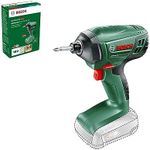Buying Guide for the Best Impact Drivers
Choosing the right impact driver can make a significant difference in your DIY projects or professional work. An impact driver is a powerful tool designed to drive screws and bolts with high torque, making it ideal for heavy-duty tasks. To find the best fit for you, it's important to understand the key specifications and how they align with your needs. Here are the main specs to consider when selecting an impact driver.TorqueTorque is the rotational force that the impact driver can apply. It's measured in inch-pounds (in-lbs) or Newton-meters (Nm). Higher torque means the driver can handle tougher materials and larger screws or bolts. For light-duty tasks like assembling furniture, a torque of around 800-1000 in-lbs is sufficient. For more demanding jobs like construction or automotive work, look for a torque of 1500 in-lbs or higher. Choose the torque based on the type of projects you plan to undertake.
Speed (RPM)Speed, measured in revolutions per minute (RPM), indicates how fast the driver can rotate. Impact drivers typically have variable speed settings, allowing you to adjust the speed based on the task. Lower speeds (0-1000 RPM) are suitable for driving screws into softer materials, while higher speeds (2000-3000 RPM) are better for drilling into harder materials. Consider the range of speeds you need for your projects and choose a driver that offers the appropriate settings.
Impacts Per Minute (IPM)Impacts Per Minute (IPM) measures how many times the driver’s hammer mechanism strikes per minute. Higher IPM means the driver can handle tougher materials more efficiently. For light to medium tasks, an IPM of 2000-3000 is adequate. For heavy-duty applications, look for an IPM of 3500 or higher. Match the IPM to the intensity of the work you plan to do.
Battery VoltageBattery voltage determines the power of a cordless impact driver. Common voltages are 12V, 18V, and 20V. A 12V driver is lightweight and suitable for light-duty tasks. An 18V or 20V driver offers more power and is better for medium to heavy-duty tasks. Choose the voltage based on the balance between power needs and tool weight, especially if you need to use the driver for extended periods.
Battery Capacity (Ah)Battery capacity, measured in ampere-hours (Ah), indicates how long the battery will last on a single charge. Higher Ah means longer runtime. For occasional use, a 1.5-2.0 Ah battery may be sufficient. For more frequent or intensive use, consider a battery with 3.0 Ah or higher. Select the battery capacity based on how long you need the tool to run without recharging.
Chuck SizeThe chuck size determines the maximum diameter of the bit that the driver can hold. Most impact drivers have a 1/4-inch hex chuck, which is standard for most driving and drilling tasks. Ensure the chuck size is compatible with the bits you plan to use. If you need to use larger bits, look for a driver with a compatible chuck size.
Weight and ErgonomicsThe weight and ergonomics of the impact driver affect how comfortable it is to use, especially for extended periods. Lighter drivers are easier to handle and reduce fatigue, but may offer less power. Heavier drivers provide more power but can be tiring to use. Look for a driver with a comfortable grip and balanced weight that suits your strength and the duration of your tasks.
Additional FeaturesAdditional features like LED lights, brushless motors, and multiple speed settings can enhance the usability of the impact driver. LED lights are useful for working in low-light conditions. Brushless motors are more efficient and have a longer lifespan. Multiple speed settings provide more control over the tool. Consider which features will make your work easier and more efficient.

















